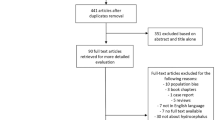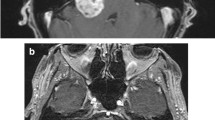Abstract
The purpose of this study was to determine the prevalence of hydrocephalus in patients with vestibular schwannoma. A second objective was to investigate possible etiologies for hydrocephalus in this population by attempting to correlate the incidence and severity of hydrocephalus with tumor volume and extent of fourth ventricular compression. The MRI examinations of 157 adult patients with vestibular schwannoma were retrospectively reviewed. Tumor size was quantified, and the presence of accompanying hydrocephalus was assessed, categorized as communicating type or non-communicating type and then rated as mild, moderate or severe (grades 1–3). Next, the degree of fourth ventricular distortion caused by tumor mass effect was evaluated and categorized as mild, moderate or severe (grades 1–3). Spearman’s rank correlation coefficient was used to test the relationships between tumor volume and (1) the extent of fourth ventricular effacement and (2) severity of hydrocephalus. Hydrocephalus was present in 28/157 (18%) cases and was categorized as mild in 11/28 (39%), moderate in 15/28 (54%) and severe in 2/28 (7%). Communicating-type hydrocephalus was present in 17/28 (61%) and non-communicating type in 11/28 (39%). There was a positive correlation between the grade of non-communicating hydrocephalus and tumor volume (r=0.38; P<0.001) and between the severity of fourth ventricular compression and extent of hydrocephalus in this group(r=0.43; P<0.001). In patients who were classified as having communicating hydrocephalus, the correlation between tumor volume and the severity of hydrocephalus was poor (r=0.19; P=0.02) as was the correlation between the extent of fourth ventricular distortion and the severity of hydrocephalus (r=0.21; P<0.01). There is a high prevalence of hydrocephalus in patients with vestibular schwannoma. In a minority of cases non-communicating type hydrocephalus is present and the severity of hydrocephalus can be attributed to the affect of tumor volume on fourth ventricular compression. More commonly, however, communicating-type hydrocephalus exists and the correlation between the severity of fourth ventricular compression and extent of hydrocephalus is poor. Therefore, other etiologies for hydrocephalus, such as tumor protein sloughing, are likely relevant.



Similar content being viewed by others
References
Steenerson RL, Payne N (1992) Hydrocephalus in the patient with acoustic neuroma. Otolaryngol Head Neck Surg 107:25–39
Pappada G, Formaggio G, Regalia F, Panzarasa G, Geuna E (1984) Course of intracranial pressure after extirpation of posterior fossa tumours. Acta Neurochir (Wien) 70:11–19
Pirouzmand F, Tator CH, Rutka J (2001) Management of hydrocephalus associated with vestibular schwannoma and other cerebellopontine angle tumors. Neurosurgery 48:1246–1253
Briggs RJ, Shelton C, Kwartler JA, Hitselberger W (1993) Management of hydrocephalus resulting from acoustic neuromas. Otolaryngol Head Neck Surg 109:1020–1024
Kuhne D, Schmidt H, Janzen RWC, Lachenmayer L (1977) Kommunizierender hydrocephalus beim acusticusneurinom. Radiologe 17:478–481
Noren G (1998) Long-term complications following gamma knife radiosurgery of vestibular schwannomas. Stereotact Funct Neurosurg 70 [Suppl 1]:65–73
Noren G, Arndt J, Hindmarsh T (1983) Stereotactic radiosurgery in cases of acoustic neurinoma: further experiences. Neurosurgery 13:12–22
Harris PH (1962) Chronic progressive communicating hydrocephalus due to protein transudates from brain and spinal tumors. Dev Med Child Neurol 4:270–278
Pollock BE, Lunsford LD, Noren G (1998) Vestibular schwannoma management in the next century: a radiosurgical perspective. Neurosurgery 43:475–481
Gammal TE, Allen MB, Brooks BS, Mark EK (1987) MR evaluation of hydrocephalus. AJR Am J Roentgenol 149:807–813
Kurihara Y, Simonson T, Nguyen H, Fisher D, Lin CS, Sato Y, Yuh WT (1995) MR imaging of ventriculomegaly—a qualitative and quantitative comparison of communicating hydrocephalus, central atrophy, and normal studies. J Magn Reson Imag 5:451–456
Atlas MD, Perez de Tagle JR, Cook JA, Sheehy JP, Fagan PA (1996) Evolution of the management of hydrocephalus associated with acoustic neuroma. Laryngoscope 106:204–206
Hirano A, Dembitzer HM, Zimmerman HM (1972) Fenestrated blood vessels in neurilemoma. Lab Invest 27:305–309
Author information
Authors and Affiliations
Corresponding author
Rights and permissions
About this article
Cite this article
Rogg, J.M., Ahn, S.H., Tung, G.A. et al. Prevalence of hydrocephalus in 157 patients with vestibular schwannoma. Neuroradiology 47, 344–351 (2005). https://doi.org/10.1007/s00234-005-1363-y
Received:
Accepted:
Published:
Issue Date:
DOI: https://doi.org/10.1007/s00234-005-1363-y




